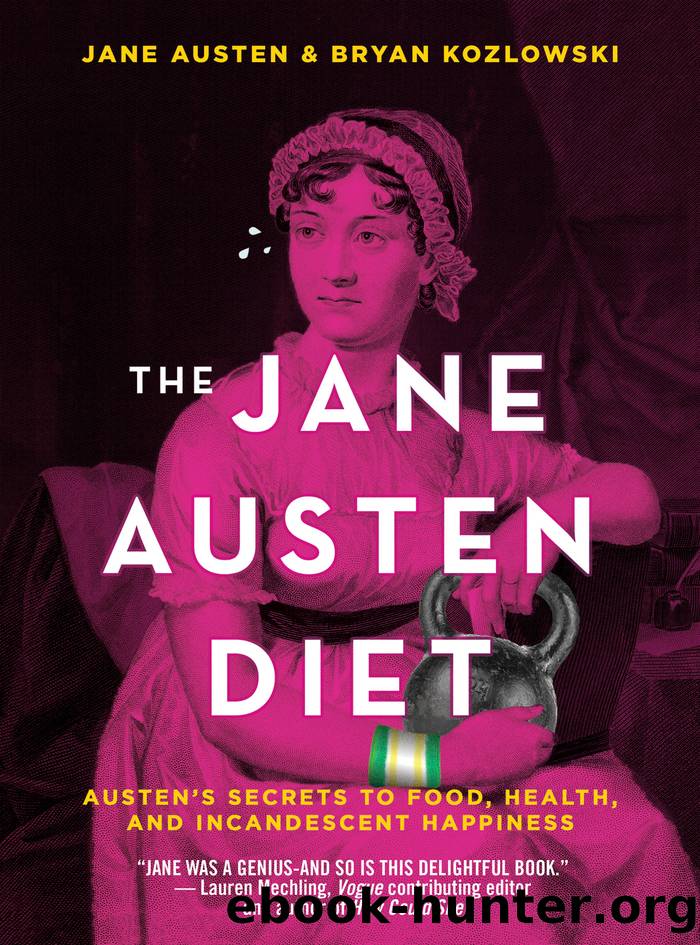The Jane Austen Diet by Bryan Kozlowski

Author:Bryan Kozlowski
Language: eng
Format: epub
Publisher: Turner Publishing Company
Published: 2019-08-15T00:00:00+00:00
As for the more stationary bodies of Austenworld, Jane is equally clear about the consequences. âIll healthâ and âa great deal of indolenceâ define Lady Bertram in Mansfield Park, her bum permanently plastered to the sofa throughout the novel. Another perpetual sitter, Mr. Woodhouse in Emma, looks and feels âa much older manâ than he really is. âWithout activity ⦠of body,â a simple half-mile stroll is beyond his comprehension. It is âsuch a distance,â he mutters weakly, âI could not walk half so far.â Then thereâs Persuasion, where we first meet Mary Musgrove âlying on the faded sofa,â and soon pick up on Austenâs hint that Maryâs frequent illnesses are a direct result of her ânot being supposed a good walker.â
This was common knowledge circa 1800. Georgian doctors viewed the body as a sort of machine (the machina carnis, they called it) that needs regular movement to work properly.4 âThere must be frequent motions,â said Joseph Addison in 1711, or the âengineâ of the body is liable to rust up.5 Itâs why Austen characters, people like Frank Churchill in Emmaâwho sit âstill when he ought to moveââare always playing a risky game with their health.
Itâs fascinating to witness how modern science has recently returned to that core belief. The very un-Regency phenomenon of seeing exercise as only that sweaty thing you do between this-and-that oâclock is entirely wrong. Moving more throughout the day is now regarded as markedly healthier than spending an exhausting hour at the gym after a full day of sitting. Your body is indeed a sort of machina carnis, a biological engine that runs best when you move it more frequently (not necessarily more vigorously)âa fact first ârediscoveredâ in 1953 when scientists in Britain observed that workers who stood or moved more throughout the day (i.e., train conductors on their feet collecting fares, postmen on their bikes delivering letters) had less coronary heart disease than workers with more sedentary jobs (bus drivers, office workers).6 Sitting for a prolonged period of time throughout the day (Ã la Lady Bertram) effectively shuts your body engine down: muscles stop firing, blood stops circulating properly, and the mechanisms that regulate healthy blood sugar and cholesterol levels deteriorateâall dramatically increasing your risk of obesity, heart disease, and diabetes.7
âSitting is the new smoking,â say umpteen-thousand articles published every year, no doubt a happy vindication for Mrs. Norris in Mansfield Park. âIdling away allâ your time âupon a sofaâ is âa very foolish trick.â But those articles are a bore, Mrs. Norris is a twit, and Austen, youâll remember, never liked to âdwell on guilt and misery.â So letâs quickly turn to her antidote for all of this âidleness and follyââthe best ways to get moving with the best bodies of Austenworld. And it begins with nothing âbeyond a walk.â
âI Walk: I Prefer Walkingâ
I wonât beat around the shrubbery. Everything happens on a walk in Janeâs novels: Darcy proposes to Elizabeth on a walk; Marianne meets Willoughby on a walk; Lucy Steele drops
Download
This site does not store any files on its server. We only index and link to content provided by other sites. Please contact the content providers to delete copyright contents if any and email us, we'll remove relevant links or contents immediately.
How to Be a Bawse: A Guide to Conquering Life by Lilly Singh(7438)
Deep Work by Cal Newport(6969)
The Longevity Diet by Valter Longo(5043)
The Fat Loss Plan by Joe Wicks(4879)
The Four-Pack Revolution by Chael Sonnen & Ryan Parsons(3947)
The Ultimate Bodybuilding Cookbook by Kendall Lou Schmidt(3909)
The French Women Don't Get Fat Cookbook by Mireille Guiliano(3632)
Super Food Family Classics by Jamie Oliver(3385)
Not a Diet Book by James Smith(3380)
Factfulness_Ten Reasons We're Wrong About the World_and Why Things Are Better Than You Think by Hans Rosling(3218)
Turn Up Your Fat Burn! by Alyssa Shaffer(3197)
Self-Esteem by Matthew McKay & Patrick Fanning(3116)
Tom Kerridge's Dopamine Diet: My low-carb, stay-happy way to lose weight by Kerridge Tom(3084)
Body Love by Kelly LeVeque(3031)
The Unbecoming of Mara Dyer by Michelle Hodkin(3020)
The Fat Chance Cookbook by Robert H. Lustig(2813)
Tone Your Tummy Type by Denise Austin(2813)
LL Cool J's Platinum 360 Diet and Lifestyle by LL Cool J(2712)
Men's Health Best by Men's Health Magazine(2574)
